Whitewater Rafting in Uganda takes you for an amazing experience along the Nile and Jinja town. Before John Hanning Speak discovered the source of the river Nile and the arrival of the British colonialists, Jinja was a small fishing village on the banks of the river Nile. When Uganda become a colony of Britain, the fishing village grew into a large trading centre with the Nile River an important crossing point to the Eastern part of the country all the way to Kenya. The town continued to grow as more and more Europeans, Indians and Ugandans settled in it.
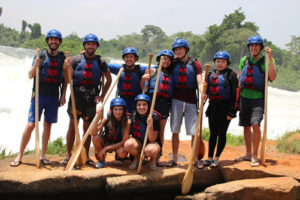 When the railway and hydroelectricity power was introduced, Jinja quickly became the most industrialized town in Uganda. However the turbulent Idi Amin regime between 1972 and 1979 caused Jinja to start losing its position as the Industrial hub of Uganda. The declining trend continued when Idi Amin expelled all Asians in Uganda depriving the industries of the required expertise. Jinja has never recovered it position even when the return of the Asians. Kampala has now overtaken it as the industrial centre of Uganda. All was not lost though because while it lost its industrial status, tourism has thrived. Jinja and Uganda as a whole is a great place to experience the beauty of Africa. Apart from the serenity of the town, tourists are attracted to Jinja because the river Nile and Lake Victoria. The quiet town is perfect for relaxation and rest after visiting Uganda’s national parks.
When the railway and hydroelectricity power was introduced, Jinja quickly became the most industrialized town in Uganda. However the turbulent Idi Amin regime between 1972 and 1979 caused Jinja to start losing its position as the Industrial hub of Uganda. The declining trend continued when Idi Amin expelled all Asians in Uganda depriving the industries of the required expertise. Jinja has never recovered it position even when the return of the Asians. Kampala has now overtaken it as the industrial centre of Uganda. All was not lost though because while it lost its industrial status, tourism has thrived. Jinja and Uganda as a whole is a great place to experience the beauty of Africa. Apart from the serenity of the town, tourists are attracted to Jinja because the river Nile and Lake Victoria. The quiet town is perfect for relaxation and rest after visiting Uganda’s national parks.
The river Nile offers some of the best adrenaline raising activities on earth like Bungee jumping, Quad biking, horseback riding and Whitewater rafting which is the subject of this article.
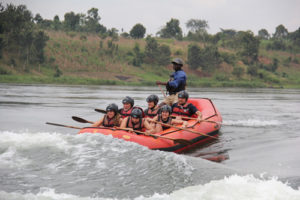 Whitewater rafting is a great sport that teaches how to remain calm under great pressure. The opportunity to do whitewater rafting from the longest river on earth is amazing. It is one of the best things to do in Uganda. The river Nile has been a source of water for several civilizations. Whitewater rafting in Jinja takes you in the middle of the river Nile while passing through chaotic and turbulent rapids. The Nile rapids in Jinja are graded 4 and 5 and offer the best whitewater rafting experiences in Africa. The rapids flow with more volume and power than those in river Zambezi. Although the recent construction of the Bujagali and Isimba dams have led to the destruction of some of the Grade five rapids like Namizi, The Bad Place and Kyabirwa, whitewater rafting remains intact. Rafting companies have had to adjust and change their launching point and overall route further downstream but while still offering the same adrenaline rush and beautiful scenery that it used to be.
Whitewater rafting is a great sport that teaches how to remain calm under great pressure. The opportunity to do whitewater rafting from the longest river on earth is amazing. It is one of the best things to do in Uganda. The river Nile has been a source of water for several civilizations. Whitewater rafting in Jinja takes you in the middle of the river Nile while passing through chaotic and turbulent rapids. The Nile rapids in Jinja are graded 4 and 5 and offer the best whitewater rafting experiences in Africa. The rapids flow with more volume and power than those in river Zambezi. Although the recent construction of the Bujagali and Isimba dams have led to the destruction of some of the Grade five rapids like Namizi, The Bad Place and Kyabirwa, whitewater rafting remains intact. Rafting companies have had to adjust and change their launching point and overall route further downstream but while still offering the same adrenaline rush and beautiful scenery that it used to be.
What to expect during whitewater rafting in Jinja
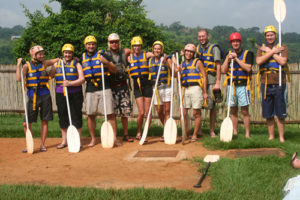 A day of whitewater rafting starts with early morning breakfast before being transferred to the banks of the river. All participants are required to leave their valuable and dry clothes in the car with staff. The teams are given orientation about safety and what to expect. The orientation is supervised by guides who are very experienced and knowledgeable about the area and rapids. They go through every aspect of safety to ensure that all rafters have the best possible experience. Other topics covered include how to get hold of the rope for safety, how to paddle and how to fall out of the raft in the right way. Participants are advised to remain as calm as possible if they trip over while holding their breath. Always travel with extra underwear and dry clothes. Choose clothes that dry fast because you will be in and out of water several times.
A day of whitewater rafting starts with early morning breakfast before being transferred to the banks of the river. All participants are required to leave their valuable and dry clothes in the car with staff. The teams are given orientation about safety and what to expect. The orientation is supervised by guides who are very experienced and knowledgeable about the area and rapids. They go through every aspect of safety to ensure that all rafters have the best possible experience. Other topics covered include how to get hold of the rope for safety, how to paddle and how to fall out of the raft in the right way. Participants are advised to remain as calm as possible if they trip over while holding their breath. Always travel with extra underwear and dry clothes. Choose clothes that dry fast because you will be in and out of water several times.
Before the activity begins, individuals are given an opportunity to choose between an easy or more difficult route. Those who are not prepared for the Grade 4 and 5 Levels can opt for the Grade 3 rafting. Families have an option of going for the slower family float trip designed to enjoy the river while avoiding the main rapids. All participants are required to sign a form with details about any ailments. You cannot go for rafting with hypertension or anemia. 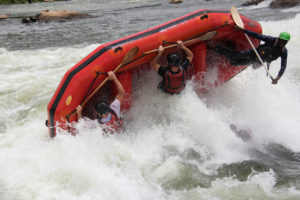 Once the orientation is done, helmets and waterproof jackets fastened, the activity can begin. The first mile or so gives the guides more time to train all participants fully before the rapids get stronger and more spectacular downstream. Whenever you reach the next rapid, the guides arrange for a vote of whether to go through the easy route (edges) or the hard way (middle). If the majority votes for the hard way, then there is nothing you can do but prepare for the challenge. The experienced rafters are taken to the strongest section of currents to allow them tip over. If the leading a group of inexperienced members, the team leader will approach each rapid at the weakest/easiest part so that they don’t trip over. In case the inexperienced group encounters a large rapid, they get out of their rafts and walk around it. Steering through each rapid offers a different experience and depends entirely on how the lead guide navigates.
Once the orientation is done, helmets and waterproof jackets fastened, the activity can begin. The first mile or so gives the guides more time to train all participants fully before the rapids get stronger and more spectacular downstream. Whenever you reach the next rapid, the guides arrange for a vote of whether to go through the easy route (edges) or the hard way (middle). If the majority votes for the hard way, then there is nothing you can do but prepare for the challenge. The experienced rafters are taken to the strongest section of currents to allow them tip over. If the leading a group of inexperienced members, the team leader will approach each rapid at the weakest/easiest part so that they don’t trip over. In case the inexperienced group encounters a large rapid, they get out of their rafts and walk around it. Steering through each rapid offers a different experience and depends entirely on how the lead guide navigates.
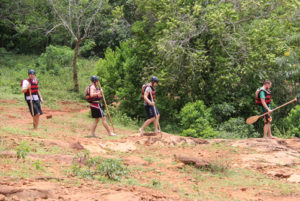 The main route has 9 main rapids, four of which are grade 5. The rapids become stronger and quicker as you go downstream. In-between the rapids are calm waters and islands were participants can relax, swim, take lunch or marvel at the beautiful scenery. A day of whitewater rafting can cover a distance of up to 26 kilometers. Expect to encounter locals fishing and drying their clothes by the riverside. The river in Jinja is a birders paradise with over 100 species. Keen observers might even spot vervet monkeys swinging on top of trees along the river bank. After the activity, a small party is organized where participants are offered free drinks and transportation back at the lodge.
The main route has 9 main rapids, four of which are grade 5. The rapids become stronger and quicker as you go downstream. In-between the rapids are calm waters and islands were participants can relax, swim, take lunch or marvel at the beautiful scenery. A day of whitewater rafting can cover a distance of up to 26 kilometers. Expect to encounter locals fishing and drying their clothes by the riverside. The river in Jinja is a birders paradise with over 100 species. Keen observers might even spot vervet monkeys swinging on top of trees along the river bank. After the activity, a small party is organized where participants are offered free drinks and transportation back at the lodge.
Is white water rafting safe in Jinja Uganda?
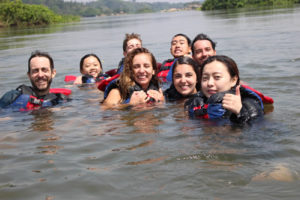 Whitewater rafting is 100% safe because the crew is highly trained and experienced in navigating though the rapids. It is important to follow instructions from the guides for your on safety and enjoyment. Participants are given life jackets and strong helmets to protect them from in case they trip over. Talking about tripping over, one needs to hold on to the ropes around the raft or raise their knees to their chest each time they plunge beneath the waves.
Whitewater rafting is 100% safe because the crew is highly trained and experienced in navigating though the rapids. It is important to follow instructions from the guides for your on safety and enjoyment. Participants are given life jackets and strong helmets to protect them from in case they trip over. Talking about tripping over, one needs to hold on to the ropes around the raft or raise their knees to their chest each time they plunge beneath the waves.
The river Nile has deep waters and one doesn’t need to worry much about falling on rocks. Rafting in many countries is more dangerous because you can hit on a rock when you fall even though the waves are smaller. It is why the guides in Jinja are more willing to let the rafts flip over several times because the threat from the rocks is minimal.
Moreover, there are several rescue teams that move ahead of the group in Kayaks with the task of rescuing any stranded rafters. The rescue team is also responsible for carrying snacks and fresh fruit that are consumed during the main break. Apart from the rescue Kayaks, there are also the safety boats that take away participants who no longer wish to continue.
The rafts for families with younger children and adolescents do not go through the largest and most difficult rapids. They take a different route passing through smaller rapids and scenic islands to explore the forests and other channels of the river.
Important information about white water rafting in Jinja
- There are about four companies offering whitewater rafting services in Jinja including Nalubale Rafting, Nile River Explorers and Adrift. The activity can be booked through the companies directly or a good tour operator.
- The cost of white water rafting ranges between $145 and $255 depending on if the activity is full day or half day. 2 Days Jinja Whitewater rafting is the most expensive category and usually starts with a tour of Jinja town and the source of the Nile.
- You do not need to worry about photos. The safety Kayakers and rafters carry equipment and a camera person to capture the moments. The The photos can be bought stored on a CD at the finishing point at a cost of about $70 for each raft.
- The best time to go for white water- rafting in Jinja is during the drier seasons of January to February or June to September. During the dry periods of the year, the skies are clear with strong sunlight. It is important to apply sunscreen to avoid getting a red skin.
- You need extra clothes for use after rafting and money for extra expenses.
- Instead of the standard whitewater rafting, travelers can for choose to go Jet Boat riding. This involves taking a speed boat to race down the rapids of the Nile in Jinja. All participants are provided with life jackets and helmets. The Jet boats are manufactured from New Zealand and very experienced crew. Jet boat riding costs $75 for adults and $50 for kids under 12.
- Tubing the Nile is another exciting activity worth considering while visiting Jinja and the Nile River. This involves drifting on the Nile using an inflated tube while watching birds, sunbathing and marveling at the beautiful scenery around the Nile. The activity can be arranged on level/calm waters or close to the rapids.
- Whitewater rafting can be combined with other major activities like gorilla trekking in Bwindi, Visiting the Murchison Falls National Park or Queen Elizabeth National Park.
